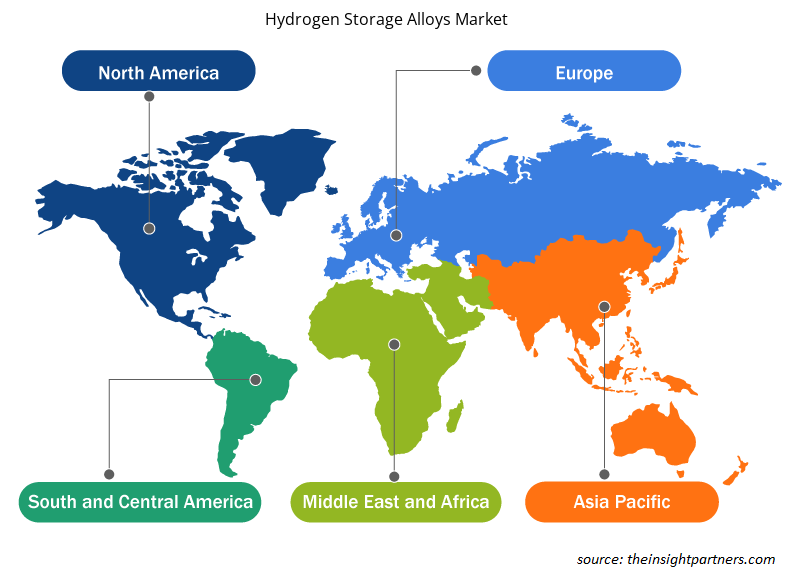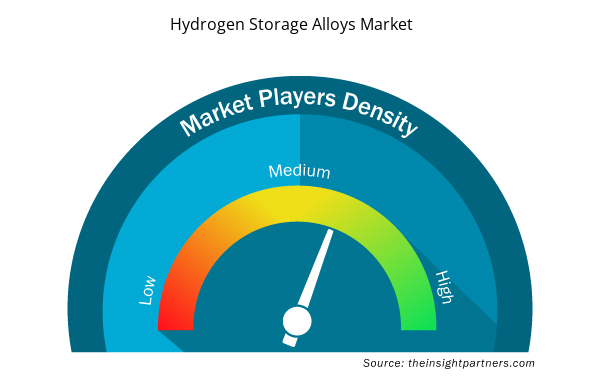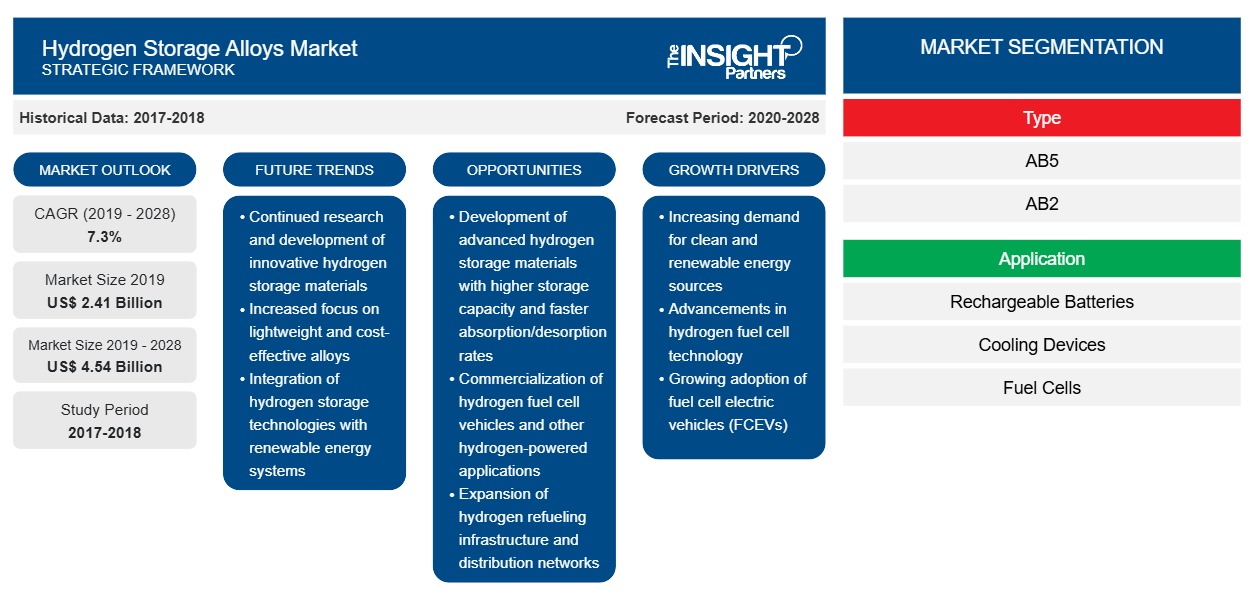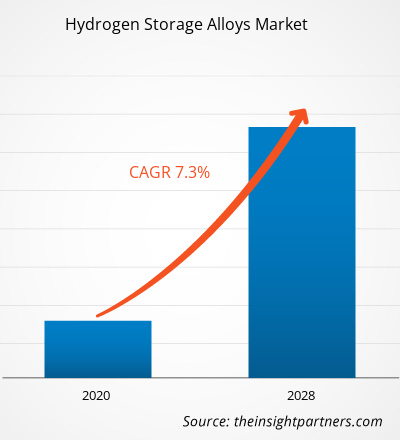بلغت قيمة سوق سبائك تخزين الهيدروجين 2,406.88 مليون دولار أمريكي في عام 2019 ومن المتوقع أن تصل إلى 4,535.53 مليون دولار أمريكي بحلول عام 2028؛ ومن المتوقع أن تنمو بمعدل نمو سنوي مركب قدره 7.3٪ من عام 2020 إلى عام 2028.
تصنف سبائك تخزين الهيدروجين إلى مركبات بين معدنية من عدة أنواع مثل AB5 وAB2 وAB وA2B. حيث تتكون عناصر المجموعة A بشكل أساسي من La وTi وZr وMg وما إلى ذلك وتتكون عناصر المجموعة B من Ni وCo وFe وMn وما إلى ذلك، والتي تكون هيدريداتها مستقرة ترموديناميكيًا وغير مستقرة على التوالي. ومن بين هذه السبائك، تعد AB5 وAB2 أكثر سبائك تخزين الهيدروجين استخدامًا على نطاق واسع. هذه السبائك هي مواد معدنية تتمتع بقدرة فريدة على امتصاص وإطلاق كميات كبيرة من الهيدروجين بشكل عكسي من الطور الغازي أو كهروكيميائيًا.
في عام 2019، كانت أمريكا الشمالية أكبر سوق لسبائك تخزين الهيدروجين. يزداد الطلب المتزايد على التقنيات الصديقة للبيئة لصناعة السيارات بشكل كبير، وهذا يفتح إمكانيات جديدة للاعب جديد في قطاع التنقل، الهيدروجين، الذي يدفع سوق سبائك تخزين الهيدروجين في منطقة أمريكا الشمالية. أحد عوامل النمو الرئيسية لسوق سبائك تخزين الهيدروجين في أمريكا الشمالية هو أنها مصممة خصيصًا لتلبية تطبيقات العملاء. علاوة على ذلك، تشارك العديد من الشركات في الولايات المتحدة مثل JMC، Inc.، FuelCell Energy، Inc. بنشاط في تصميم وتصنيع أوعية تخزين الهيدروجين للتطبيقات المستقبلية والحالية، مما يعزز الطلب على سبائك تخزين الهيدروجين خلال فترة التنبؤ. أدى الطلب المتزايد على المنتجات الإلكترونية في المنطقة إلى خلق سوق جذابة للمواد الكيميائية الهيدروجينية. لذلك، من المتوقع أن يعزز التقدم التكنولوجي والنمو في الصناعة الإلكترونية الطلب على سبائك تخزين الهيدروجين خلال فترة التنبؤ.
لقد غير الوباء المستمر بشكل كبير وضع صناعة توليد الهيدروجين وأثر سلبًا على نمو سوق سبائك تخزين الهيدروجين. لقد أدى تفشي COVID-19 إلى تشويه الكفاءة التشغيلية وتعطيل سلاسل القيمة بسبب الإغلاق المفاجئ للحدود الوطنية والدولية، مما أدى إلى خسارة في الإيرادات وأضرار. على سبيل المثال، وفقًا لتقرير نشرته Energy Industry Review، فإن الأزمة الاقتصادية المصاحبة للوباء قد تؤدي إلى تأخير كبير في تبني وتسويق طاقة الهيدروجين النظيفة. وقد يؤثر هذا أيضًا على قدرة قطاع الهيدروجين على العمل بسلاسة باعتباره الحلقة المفقودة في انتقال الطاقة. كان لسلسلة القيمة المعطلة تأثير سلبي على إمدادات المواد الخام، مما يؤثر بدوره على نمو سوق سبائك تخزين الهيدروجين. ومع ذلك، مع تخطيط الاقتصادات لإحياء عملياتها، من المتوقع أن يرتفع الطلب على سبائك تخزين الهيدروجين عالميًا. على الرغم من أن التركيز على الإنتاج في الوقت المناسب هو عامل آخر مثير للقلق يعيق نمو السوق. مع التركيز المتزايد على الاقتصاد القائم على الهيدروجين في أوقات ما بعد الوباء، من المتوقع أن يقفز الطلب على سبائك تخزين الهيدروجين بشكل كبير بسبب توسيع قواعد التطبيق. علاوة على ذلك، فإن التدابير الإيجابية التي اتخذتها الحكومة إلى جانب الأجيال الموزعة ودمج التكنولوجيا المتقدمة تشكل عاملاً آخر من المتوقع أن يعزز نمو السوق.
قم بتخصيص هذا التقرير ليناسب متطلباتك
ستحصل على تخصيص لأي تقرير - مجانًا - بما في ذلك أجزاء من هذا التقرير، أو تحليل على مستوى الدولة، وحزمة بيانات Excel، بالإضافة إلى الاستفادة من العروض والخصومات الرائعة للشركات الناشئة والجامعات
- احصل على أهم اتجاهات السوق الرئيسية لهذا التقرير.ستتضمن هذه العينة المجانية تحليلاً للبيانات، بدءًا من اتجاهات السوق وحتى التقديرات والتوقعات.
رؤى السوق
ارتفاع متزايد في أنظمة توليد وتخزين الهيدروجين
يعتبر الهيدروجين أحد العناصر المهمة ومتوفر بكثرة في الحالة الغازية. وقد لفت الاستخدام المحتمل للهيدروجين كمصدر حيوي للطاقة انتباهًا كبيرًا في السنوات الأخيرة في تطبيقات مختلفة وفقًا لجمعية خلايا الوقود وطاقة الهيدروجين، فإن التركيز المتزايد نحو استبدال مصادر الطاقة المتجددة بمصادر طاقة مختلفة قابلة للإرسال قد دفع بشكل كبير الطلب على توليد الهيدروجين وتخزينه. وفقًا للجمعية، فإن تخزين طاقة الهيدروجين هو تقنية لتخزين الطاقة الفائضة، التي تولدها مصادر الطاقة المتجددة، بحيث يمكن استخدامها لأغراض مختلفة مثل الوقود لمحركات المكبس أو توربينات الغاز وغيرها. وفقًا لوكالة الطاقة الدولية، فإن الهيدروجين الناتج عن آلية التحليل الكهربائي يحمل فرصًا مستقبلية كبيرة واعدة كخيار وقود اقتصادي ويتوقع أن يكون الهيدروجين الناتج عن مصادر الرياح فعالاً من حيث التكلفة وأرخص من الغاز الطبيعي بحلول عام 2030. لذلك، من المتوقع أن يرتفع الطلب على توليد الهيدروجين وتخزينه، ربما في الكهوف تحت الأرض لتخزين الطاقة على نطاق واسع أو حاويات فولاذية في تخزين أصغر نطاقًا. ومن المتوقع أن يؤدي التركيز المتزايد على الهيدروجين كمصدر محتمل للطاقة المتجددة إلى جانب الطلب المتزايد على تخزين طاقة الهيدروجين إلى تحفيز الطلب على سبائك تخزين الهيدروجين في السوق العالمية. وعلى نحو مماثل، تم استخدام العديد من التقنيات بشكل كبير لتخزين الهيدروجين، بما في ذلك سبائك تخزين الهيدروجين، وتخزين غاز الهيدروجين عالي الضغط، وتخزين الهيدروجين السائل، وغيرها في محطات التزود بالوقود بالهيدروجين.renewables with different dispatchable energy sources has substantially driven the demand for hydrogen generation and storage. As per the association, hydrogen energy storage is technique of storing surplus energy, generated by renewables, so that it can be used for various purposes such as fuel for piston engines or gas turbines and others. As per International Energy Agency, hydrogen generated with the help of electrolysis mechanism holds great futuristic opportunities great promise as an economic fuel choice and predicts that such hydrogen created from wind sources would be comparatively be cost-efficient and cheaper than natural gas by 2030. Therefore, the demand for hydrogen generation and storage, potentially in underground caverns for large-scale energy storage or steel containers in smaller scale storage, is expected to rise. The growing focus over hydrogen as potential renewable energy source along with expanding demand for hydrogen energy storage is expected to stimulate the demand for hydrogen storage alloys in global market. Correspondingly, several techniques have been significantly used to store hydrogen, including hydrogen storage alloys, high-pressure hydrogen gas storage, liquid hydrogen storage, and others at hydrogen refueling stations.
رؤى النوع
بناءً على النوع، يتم تقسيم سوق سبائك تخزين الهيدروجين إلى AB5 وAB2. قادت شريحة AB5 سوق سبائك تخزين الهيدروجين بأعلى حصة سوقية في عام 2019. تعد سبيكة تخزين الهيدروجين من النوع AB5 Mm (Ni، Mn، Co، Al)5 واحدة من سلسلة سبائك يتم استخدامها على نطاق واسع الآن. وقد ثبت أن سبيكة التركيب MmNi3.55Mn0.4Al0.3Co0.75 تلبي الحد الأدنى من المتطلبات للبطارية العملية فيما يتعلق بالتكلفة وعمر الدورة وسعة التخزين. تجمع سبائك AB5 بين معدن مكون للهيدريد A، وعادة ما يكون معدنًا نادرًا من الأرض (La، Ce، Nd، Pr، Y أو خليطها المعروف باسم Mischmetal)، مع عنصر مكون غير هيدريد وهو النيكل. يمكن تطعيم الأخير بمعادن أخرى، مثل Co أو Sn أو Al، لتحسين استقرار المواد أو لضبط ضغط الهيدروجين المتوازن ودرجة الحرارة المطلوبة لشحنه وتفريغه بالهيدروجين. ومن المتوقع أن يؤدي هذا بدوره إلى دفع نمو السوق خلال الفترة المتوقعة.hydride forming metal A, usually a rare earth metal (La, Ce, Nd, Pr, Y or their mixture known as Mischmetal), with a non-hydride forming element that is nickel. The latter can be doped with other metals, such as Co, Sn or Al, to improve materials stability or to adjust equilibrium hydrogen pressure and temperature required for its charging discharging with hydrogen. This, in turn, is anticipated to drive the growth of the market during the forecast period.
رؤى التطبيق
بناءً على التطبيق، يتم تقسيم سوق سبائك تخزين الهيدروجين إلى بطاريات قابلة لإعادة الشحن وأجهزة تبريد وخلايا وقود وغيرها. تعد البطاريات القابلة لإعادة الشحن واحدة من أهم التقنيات لمركبات الطاقة الجديدة. من بينها، تم استخدام بطاريات هيدريد النيكل المعدني (Ni-MH) في وقت مبكر وعلى نطاق واسع في المركبات الهجينة نظرًا لقدرتها العالية على الطاقة وتحملها للشحن الزائد أو التفريغ والتوافق مع البيئة والسلامة. الميزة الرئيسية للبطارية هي أنها تحافظ على كل من الإلكتروليت القلوي وكاثود هيدروكسيد النيكل الموجب المتطور لبطاريات NiCad، مما ينتج عنه زيادة مذهلة في طاقة الحجم (من 120 Wh.L-1 لـ Ni-Cad إلى 240 Wh.L-1 لـ Ni-MH). علاوة على ذلك، كان البديل للكادميوم السام للبيئة أيضًا مفيدًا بشكل كبير. أخيرًا، لا تنطوي التفاعلات الكهروكيميائية للشحن والتفريغ لبطارية Ni-MH على الماء بحيث يظل محتوى الماء ثابتًا في الخلية طوال الدورة بأكملها، على عكس تلك الموجودة في بطاريات Ni-Cad. علاوة على ذلك، فإن المركب الثنائي غير مناسب لأنود في البطاريات المفتوحة لأن هيدريده (LaNi5H6) يتحلل تلقائيًا في ظل الظروف العادية للضغط ودرجة الحرارة.
تشمل الجهات الفاعلة الرئيسية في السوق JMC وMerck KGaA وAjax Tocco Magnethermic Corporation وBaotou Santoku Battery Materials Co.، Ltd. وSantoku Corporation وAmerican Elements وAMG Titanium Alloys & Coatings LLC وJiangmen Kanhoo Industry Co.، Ltd وXiamen Tungsten Co.، Ltd. يركز اللاعبون الرئيسيون في سوق سبائك تخزين الهيدروجين على استراتيجيات مثل عمليات الدمج والاستحواذ وإطلاق المنتجات لزيادة الوجود الجغرافي وقاعدة المستهلكين عالميًا.
تقرير يسلط الضوء على
- اتجاهات الصناعة التقدمية في سوق سبائك تخزين الهيدروجين العالمية لمساعدة اللاعبين على تطوير استراتيجيات فعالة طويلة الأجل
- استراتيجيات نمو الأعمال التي تتبناها الأسواق المتقدمة والنامية
- التحليل الكمي لسوق سبائك تخزين الهيدروجين العالمية من عام 2017 إلى عام 2027
- تقدير الطلب على سبائك تخزين الهيدروجين عبر مختلف الصناعات
- تحليل PEST لتوضيح فعالية المشترين والموردين العاملين في الصناعة للتنبؤ بنمو السوق
- التطورات الأخيرة لفهم سيناريو السوق التنافسي والطلب على سبائك تخزين الهيدروجين
- اتجاهات السوق والتوقعات إلى جانب العوامل التي تدفع وتحد من نمو سوق سبائك تخزين الهيدروجين
- عملية اتخاذ القرار من خلال فهم الاستراتيجيات التي تدعم المصلحة التجارية فيما يتعلق بنمو سوق سبائك تخزين الهيدروجين العالمية
- حجم سوق سبائك تخزين الهيدروجين في مختلف عقد السوق
- نظرة عامة تفصيلية وتقسيم السوق العالمية لسبائك تخزين الهيدروجين بالإضافة إلى ديناميكياتها في الصناعة.
- حجم سوق سبائك تخزين الهيدروجين في مناطق مختلفة مع فرص نمو واعدة
رؤى إقليمية حول سوق سبائك تخزين الهيدروجين
لقد قام المحللون في Insight Partners بشرح الاتجاهات والعوامل الإقليمية المؤثرة على سوق سبائك تخزين الهيدروجين طوال فترة التوقعات بشكل شامل. يناقش هذا القسم أيضًا قطاعات سوق سبائك تخزين الهيدروجين والجغرافيا في جميع أنحاء أمريكا الشمالية وأوروبا ومنطقة آسيا والمحيط الهادئ والشرق الأوسط وأفريقيا وأمريكا الجنوبية والوسطى.

- احصل على البيانات الإقليمية المحددة لسوق سبائك تخزين الهيدروجين
نطاق تقرير سوق سبائك تخزين الهيدروجين
| سمة التقرير | تفاصيل |
|---|---|
| حجم السوق في عام 2019 | 2.41 مليار دولار أمريكي |
| حجم السوق بحلول عام 2028 | 4.54 مليار دولار أمريكي |
| معدل النمو السنوي المركب العالمي (2019 - 2028) | 7.3% |
| البيانات التاريخية | 2017-2018 |
| فترة التنبؤ | 2020-2028 |
| القطاعات المغطاة | حسب النوع
|
| المناطق والدول المغطاة | أمريكا الشمالية
|
| قادة السوق وملفات تعريف الشركات الرئيسية |
|
كثافة اللاعبين في سوق سبائك تخزين الهيدروجين: فهم تأثيرها على ديناميكيات الأعمال
يشهد سوق سبائك تخزين الهيدروجين نموًا سريعًا، مدفوعًا بالطلب المتزايد من المستخدم النهائي بسبب عوامل مثل تفضيلات المستهلكين المتطورة والتقدم التكنولوجي والوعي المتزايد بفوائد المنتج. ومع ارتفاع الطلب، تعمل الشركات على توسيع عروضها والابتكار لتلبية احتياجات المستهلكين والاستفادة من الاتجاهات الناشئة، مما يؤدي إلى زيادة نمو السوق.
تشير كثافة اللاعبين في السوق إلى توزيع الشركات أو المؤسسات العاملة في سوق أو صناعة معينة. وهي تشير إلى عدد المنافسين (اللاعبين في السوق) الموجودين في مساحة سوق معينة نسبة إلى حجمها أو قيمتها السوقية الإجمالية.
الشركات الرئيسية العاملة في سوق سبائك تخزين الهيدروجين هي:
- شركة اليابان للمعادن والمواد الكيميائية المحدودة (JMC)
- ميرك كي جي ايه ايه
- شركة أجاكس توكو ماجنيتثيرميك
- شركة باوتو سانتوكو لمواد البطاريات المحدودة
- شركة سانتوكو
إخلاء المسؤولية : الشركات المذكورة أعلاه ليست مرتبة بأي ترتيب معين.

- احصل على نظرة عامة على أهم اللاعبين الرئيسيين في سوق سبائك تخزين الهيدروجين
السوق العالمية لسبائك تخزين الهيدروجين، حسب النوع
- أب5
- أ ب 2
السوق العالمية لسبائك تخزين الهيدروجين، حسب التطبيق
- البطاريات القابلة لإعادة الشحن
- أجهزة التبريد
- خلايا الوقود
- آحرون
ملفات تعريف الشركة
- جيه إم سي
- ميرك كي جي ايه ايه
- شركة أجاكس توكو ماجنيتثيرميك
- شركة باوتو سانتوكو لمواد البطاريات المحدودة
- شركة سانتوكو
- العناصر الأمريكية
- شركة AMG لسبائك التيتانيوم والطلاءات المحدودة
- شركة جيانجمن كانهو الصناعية المحدودة
- شركة شيامن تنجستن المحدودة
- التحليل التاريخي (سنتان)، السنة الأساسية، التوقعات (7 سنوات) مع معدل النمو السنوي المركب
- تحليل PEST و SWOT
- حجم السوق والقيمة / الحجم - عالميًا وإقليميًا وقطريًا
- الصناعة والمنافسة
- مجموعة بيانات Excel


- Virtual Pipeline Systems Market
- Hair Extensions Market
- 3D Mapping and Modelling Market
- Nuclear Waste Management System Market
- Foot Orthotic Insoles Market
- Europe Tortilla Market
- Online Recruitment Market
- Water Pipeline Leak Detection System Market
- Medical Audiometer Devices Market
- Environmental Consulting Service Market

Report Coverage
Revenue forecast, Company Analysis, Industry landscape, Growth factors, and Trends

Segment Covered
This text is related
to segments covered.

Regional Scope
North America, Europe, Asia Pacific, Middle East & Africa, South & Central America

Country Scope
This text is related
to country scope.
الأسئلة الشائعة
The rechargeable batteries segment held the largest share in the global hydrogen storage alloys market in 2019. Hydrogen storage alloys such as AB2 and AB5 are widely used in rechargeable batteries such as NiMH batteries, lithium-ion based batteries and metal-air batteries. Though the market for these batteries is currently at a mature stage and its technology offers limited scope for innovation they are vital component of the power source in consumer appliances and industrial applications. For instance, NiMH batteries installed in several gadgets such as toys, cameras electronics, other electronics and hybrid vehicles, and electric cars. Similarly, lithium-ion battery finds its major application in laptops, PDAs, cell phones, and iPods. Enhanced chemical and mechanical stability of hydrogen storage alloys make them a popular choice for these batteries. Thus, the rapid growth of the electrical and electronic sector acts as a major driver for the growth of the rechargeable batteries which eventually supports the growth of hydrogen storage alloys
The major players operating in the global hydrogen storage alloys market are JMC, Merck KGaA, Ajax Tocco Magnethermic Corporation, Baotou Santoku Battery Materials Co., Ltd., Santoku Corporation, American Elements, Hunan Corun New Energy Co., Ltd, Jiangmen Kanhoo Industry Co., Ltd, Xiamen Tungsten Co., Ltd. among many others.
In 2019, APAC contributed to the largest share in the global hydrogen storage alloys market. The growth of the hydrogen storage alloys market in this region is primarily attributed to the development of new applications such as hydrogen powered fuel cells for transportation. Escalating demand for clean energy generation has increased use of fuel cell-based vehicles which is driving the market for hydrogen storage alloys in the region. In addition, hydrogen storage alloys find vast applications in electronics devices such as smartphones, laptops, PDAs and other consumer electronics. Surge in demand for consumer electronics in developing countries such as India and China is expected to support the growth of hydrogen storage alloys market. Hydrogen storage technology has its wide application in chemicals, metal working, general industrial, transportation, stationary power, portable power, and transportation. Hydrogen storage alloys are used in fuel cell, cooling devices, rechargeable batteries and other components such as sensors, activators, purification, heat pumps. They are also used in devices used for isotope separation, thermal storage, and refrigeration. Thus, the growing demand of hydrogen storage alloys for non-electro chemical applications is projected to boost the demand for hydrogen storage alloys over the forecast period. Increasing focus on research & development (R&D) for the development of hydrogen storage technology and increasing adoption of technological advancements and growth in automotive and electronics industry in the APAC region offer lucrative business opportunities for hydrogen storage alloys.
Trends and growth analysis reports related to Chemicals and Materials : READ MORE..
The List of companies - Global Hydrogen Storage Alloys Market
- JMC (Japan Metals & Chemicals Co., Ltd.)
- Merck KGaA
- Ajax Tocco Magnethermic Corporation
- Baotou Santoku Battery Materials Co. Ltd.
- Santoku Corporation
- American Elements
- AMG Titanium Alloys & Coatings LLC
- Jiangmen Kanhoo Industry Co. Ltd
- Xiamen Tungsten Co. Ltd
The Insight Partners performs research in 4 major stages: Data Collection & Secondary Research, Primary Research, Data Analysis and Data Triangulation & Final Review.
- Data Collection and Secondary Research:
As a market research and consulting firm operating from a decade, we have published and advised several client across the globe. First step for any study will start with an assessment of currently available data and insights from existing reports. Further, historical and current market information is collected from Investor Presentations, Annual Reports, SEC Filings, etc., and other information related to company’s performance and market positioning are gathered from Paid Databases (Factiva, Hoovers, and Reuters) and various other publications available in public domain.
Several associations trade associates, technical forums, institutes, societies and organization are accessed to gain technical as well as market related insights through their publications such as research papers, blogs and press releases related to the studies are referred to get cues about the market. Further, white papers, journals, magazines, and other news articles published in last 3 years are scrutinized and analyzed to understand the current market trends.
- Primary Research:
The primarily interview analysis comprise of data obtained from industry participants interview and answers to survey questions gathered by in-house primary team.
For primary research, interviews are conducted with industry experts/CEOs/Marketing Managers/VPs/Subject Matter Experts from both demand and supply side to get a 360-degree view of the market. The primary team conducts several interviews based on the complexity of the markets to understand the various market trends and dynamics which makes research more credible and precise.
A typical research interview fulfils the following functions:
- Provides first-hand information on the market size, market trends, growth trends, competitive landscape, and outlook
- Validates and strengthens in-house secondary research findings
- Develops the analysis team’s expertise and market understanding
Primary research involves email interactions and telephone interviews for each market, category, segment, and sub-segment across geographies. The participants who typically take part in such a process include, but are not limited to:
- Industry participants: VPs, business development managers, market intelligence managers and national sales managers
- Outside experts: Valuation experts, research analysts and key opinion leaders specializing in the electronics and semiconductor industry.
Below is the breakup of our primary respondents by company, designation, and region:

Once we receive the confirmation from primary research sources or primary respondents, we finalize the base year market estimation and forecast the data as per the macroeconomic and microeconomic factors assessed during data collection.
- Data Analysis:
Once data is validated through both secondary as well as primary respondents, we finalize the market estimations by hypothesis formulation and factor analysis at regional and country level.
- Macro-Economic Factor Analysis:
We analyse macroeconomic indicators such the gross domestic product (GDP), increase in the demand for goods and services across industries, technological advancement, regional economic growth, governmental policies, the influence of COVID-19, PEST analysis, and other aspects. This analysis aids in setting benchmarks for various nations/regions and approximating market splits. Additionally, the general trend of the aforementioned components aid in determining the market's development possibilities.
- Country Level Data:
Various factors that are especially aligned to the country are taken into account to determine the market size for a certain area and country, including the presence of vendors, such as headquarters and offices, the country's GDP, demand patterns, and industry growth. To comprehend the market dynamics for the nation, a number of growth variables, inhibitors, application areas, and current market trends are researched. The aforementioned elements aid in determining the country's overall market's growth potential.
- Company Profile:
The “Table of Contents” is formulated by listing and analyzing more than 25 - 30 companies operating in the market ecosystem across geographies. However, we profile only 10 companies as a standard practice in our syndicate reports. These 10 companies comprise leading, emerging, and regional players. Nonetheless, our analysis is not restricted to the 10 listed companies, we also analyze other companies present in the market to develop a holistic view and understand the prevailing trends. The “Company Profiles” section in the report covers key facts, business description, products & services, financial information, SWOT analysis, and key developments. The financial information presented is extracted from the annual reports and official documents of the publicly listed companies. Upon collecting the information for the sections of respective companies, we verify them via various primary sources and then compile the data in respective company profiles. The company level information helps us in deriving the base number as well as in forecasting the market size.
- Developing Base Number:
Aggregation of sales statistics (2020-2022) and macro-economic factor, and other secondary and primary research insights are utilized to arrive at base number and related market shares for 2022. The data gaps are identified in this step and relevant market data is analyzed, collected from paid primary interviews or databases. On finalizing the base year market size, forecasts are developed on the basis of macro-economic, industry and market growth factors and company level analysis.
- Data Triangulation and Final Review:
The market findings and base year market size calculations are validated from supply as well as demand side. Demand side validations are based on macro-economic factor analysis and benchmarks for respective regions and countries. In case of supply side validations, revenues of major companies are estimated (in case not available) based on industry benchmark, approximate number of employees, product portfolio, and primary interviews revenues are gathered. Further revenue from target product/service segment is assessed to avoid overshooting of market statistics. In case of heavy deviations between supply and demand side values, all thes steps are repeated to achieve synchronization.
We follow an iterative model, wherein we share our research findings with Subject Matter Experts (SME’s) and Key Opinion Leaders (KOLs) until consensus view of the market is not formulated – this model negates any drastic deviation in the opinions of experts. Only validated and universally acceptable research findings are quoted in our reports.
We have important check points that we use to validate our research findings – which we call – data triangulation, where we validate the information, we generate from secondary sources with primary interviews and then we re-validate with our internal data bases and Subject matter experts. This comprehensive model enables us to deliver high quality, reliable data in shortest possible time.


 احصل على عينة مجانية لهذا التقرير
احصل على عينة مجانية لهذا التقرير